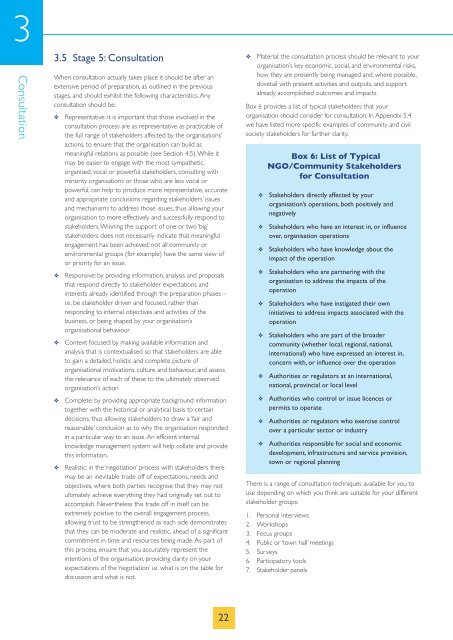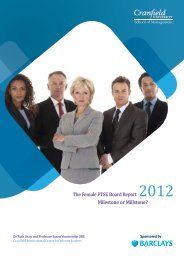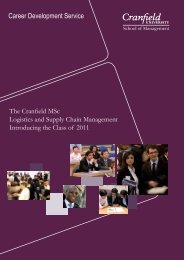Stakeholder Engagement - Cranfield School of Management ...
Stakeholder Engagement - Cranfield School of Management ...
Stakeholder Engagement - Cranfield School of Management ...
Create successful ePaper yourself
Turn your PDF publications into a flip-book with our unique Google optimized e-Paper software.
3<br />
Consultation<br />
3.5 Stage 5: Consultation<br />
When consultation actually takes place it should be after an<br />
extensive period <strong>of</strong> preparation, as outlined in the previous<br />
stages, and should exhibit the following characteristics. Any<br />
consultation should be:<br />
❖ Representative: it is important that those involved in the<br />
consultation process are as representative as practicable <strong>of</strong><br />
the full range <strong>of</strong> stakeholders affected by the organisations’<br />
actions, to ensure that the organisation can build as<br />
meaningful relations as possible (see Section 4.5).While it<br />
may be easier to engage with the most sympathetic,<br />
organised, vocal or powerful stakeholders, consulting with<br />
minority organisations or those who are less vocal or<br />
powerful, can help to produce more representative, accurate<br />
and appropriate conclusions regarding stakeholders’ issues<br />
and mechanisms to address those issues, thus allowing your<br />
organisation to more effectively and successfully respond to<br />
stakeholders.Winning the support <strong>of</strong> one or two ‘big’<br />
stakeholders does not necessarily indicate that meaningful<br />
engagement has been achieved; not all community or<br />
environmental groups (for example) have the same view <strong>of</strong><br />
or priority for an issue.<br />
❖ Responsive: by providing information, analysis and proposals<br />
that respond directly to stakeholder expectations and<br />
interests already identified through the preparation phases –<br />
i.e. be stakeholder driven and focused, rather than<br />
responding to internal objectives and activities <strong>of</strong> the<br />
business, or being shaped by your organisation’s<br />
organisational behaviour<br />
❖ Context focused: by making available information and<br />
analysis that is contextualised so that stakeholders are able<br />
to gain a detailed, holistic and complete picture <strong>of</strong><br />
organisational motivations, culture and behaviour, and assess<br />
the relevance <strong>of</strong> each <strong>of</strong> these to the ultimately observed<br />
organisation’s action<br />
❖ Complete: by providing appropriate background information<br />
together with the historical or analytical basis to certain<br />
decisions, thus allowing stakeholders to draw a ‘fair and<br />
reasonable’ conclusion as to why the organisation responded<br />
in a particular way to an issue. An efficient internal<br />
knowledge management system will help collate and provide<br />
this information.<br />
❖ Realistic: in the ‘negotiation’ process with stakeholders there<br />
may be an inevitable trade <strong>of</strong>f <strong>of</strong> expectations, needs and<br />
objectives, where both parties recognise that they may not<br />
ultimately achieve everything they had originally set out to<br />
accomplish. Nevertheless this trade <strong>of</strong>f in itself can be<br />
extremely positive to the overall engagement process,<br />
allowing trust to be strengthened as each side demonstrates<br />
that they can be moderate and realistic, ahead <strong>of</strong> a significant<br />
commitment in time and resources being made. As part <strong>of</strong><br />
this process, ensure that you accurately represent the<br />
intentions <strong>of</strong> the organisation, providing clarity on your<br />
expectations <strong>of</strong> the ‘negotiation’ i.e. what is on the table for<br />
discussion and what is not.<br />
22<br />
❖ Material: the consultation process should be relevant to your<br />
organisation’s key economic, social, and environmental risks,<br />
how they are presently being managed and, where possible,<br />
dovetail with present activities and outputs, and support<br />
already accomplished outcomes and impacts<br />
Box 6 provides a list <strong>of</strong> typical stakeholders that your<br />
organisation should consider for consultation. In Appendix 5.4<br />
we have listed more specific examples <strong>of</strong> community and civil<br />
society stakeholders for further clarity.<br />
Box 6: List <strong>of</strong> Typical<br />
NGO/Community <strong>Stakeholder</strong>s<br />
for Consultation<br />
❖ <strong>Stakeholder</strong>s directly affected by your<br />
organisation’s operations, both positively and<br />
negatively<br />
❖ <strong>Stakeholder</strong>s who have an interest in, or influence<br />
over, organisation operations<br />
❖ <strong>Stakeholder</strong>s who have knowledge about the<br />
impact <strong>of</strong> the operation<br />
❖ <strong>Stakeholder</strong>s who are partnering with the<br />
organisation to address the impacts <strong>of</strong> the<br />
operation<br />
❖ <strong>Stakeholder</strong>s who have instigated their own<br />
initiatives to address impacts associated with the<br />
operation<br />
❖ <strong>Stakeholder</strong>s who are part <strong>of</strong> the broader<br />
community (whether local, regional, national,<br />
international) who have expressed an interest in,<br />
concern with, or influence over the operation<br />
❖ Authorities or regulators at an international,<br />
national, provincial or local level<br />
❖ Authorities who control or issue licences or<br />
permits to operate<br />
❖ Authorities or regulators who exercise control<br />
over a particular sector or industry<br />
❖ Authorities responsible for social and economic<br />
development, infrastructure and service provision,<br />
town or regional planning<br />
There is a range <strong>of</strong> consultation techniques available for you to<br />
use depending on which you think are suitable for your different<br />
stakeholder groups:<br />
1. Personal interviews<br />
2. Workshops<br />
3. Focus groups<br />
4. Public or ‘town hall’ meetings<br />
5. Surveys<br />
6. Participatory tools<br />
7. <strong>Stakeholder</strong> panels
















